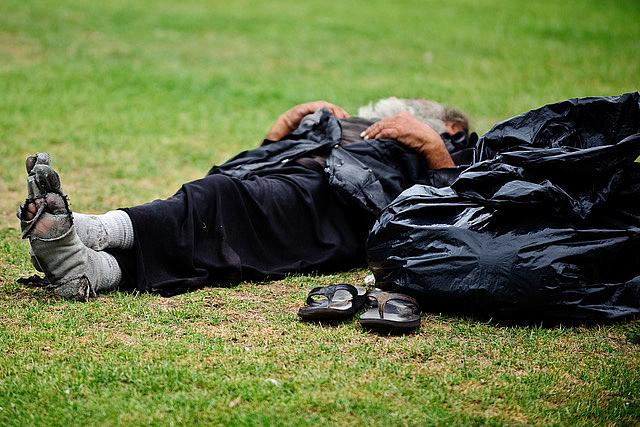Calif. approved billions for supportive homeless housing — but how will the money be spent?

[Photo by Jorge Gonzalez via Flickr.]
In the Lincoln Park homeless encampment in Los Angeles, Hugo Lira’s shanty is a landmark of blue tarp and ingenuity.
The handyman, who was displaced from his apartment by a $150 increase in monthly rent, erected his shelter on Valley Boulevard west of Soto Street and became part of a colony living in bald-tired RVs, compact cars, and camping tents.
Like Lira, most are victims of gentrification in the East Los Angeles neighborhoods near the park. But many are in need of more than affordable housing.
Some struggle with substance abuse, mental illness, or both. An elderly member of the group had collapsed and died inside one of the park’s public bathrooms. And a typhus outbreak in downtown homeless encampments to the west and Pasadena encampments to the east was declared an epidemic by public health officials last month.
“Everybody watches out for each other around here, but it’s getting rough,” Lira said on a recent morning as he and a woman from one of the RVs discussed the inability of the sickest people to keep their dwellings sanitary.
Now, there is a multibillion-dollar effort designed to help many of the estimated 134,000 homeless people in California who have been displaced by rising rents and housing shortages from the Bay to San Diego. If history is any guide, raising those funds will be the easy part. Ensuring they’re effectively spent to combat the state’s homelessness epidemic will be much harder.
California’s Proposition 2 passed overwhelmingly with 61 percent of the vote on Nov. 6, allowing the state to generate $2 billion in bond money next year alone. The influx of billions will fund housing and supportive services for those with mental illness who are on the street. The unmet needs are huge. The Los Angeles Homeless Services Authority found in its most recent survey that 27 percent of homeless people suffer from serious mental illness.
But the backstory on Proposition 2 is that its seed funds were never meant to focus on housing at all. That money had to be pried from the hands of county mental health departments after more than a decade of stakeholder sessions on how to spend it, state audits, and legal wrangling.
The bond money for Proposition 2 will be financed by funds from the Mental Health Services Act — or Proposition 63 — which itself passed with 53 percent of the California vote in 2004.
Proposition 63 levied a 1 percent tax on personal incomes above $1 million, and was criticized for failing to meet its core mandates from the start. They included requirements that its whopping $11 billion in funds be used exclusively to expand mental health services in counties that would design and tailor the programs to their local needs.
Counties were prohibited from redirecting funds to fill budget gaps in other programs. Seventy-five percent of the funding was supposed to be used for direct services to those with severe mental illness and the other 25 percent was for prevention, early intervention and innovation.
But media reports focused on questionable “innovations” in treatment, such as yoga and acupuncture for mental health patients. A review by the California State Auditor in 2013 found a troubling lack of oversight by several counties and the state mental health officials who were supposed to guide them.
Not all California counties failed to follow the intentions of the program. In 2014, I reported on effective and substantial innovations in rural Tulare County through use of Prop 63 funds. But most counties had made few concrete decisions on how to spend the money after a decade of strategy sessions with local mental health experts, who were paid for their input.
Oversight was reassigned to the California Department of Health Care Services. Finally in 2016, State Senator Kevin de León of Los Angeles proposed that up to $140 million a year be siphoned from Prop 63 to repay the billions in bonds needed to start No Place Like Home, a supportive housing program.
The tug of war over the funds wasn’t over, however.
A Sacramento lawyer who had previous represented mental hospitals in other states filed a lawsuit that blocked the establishment of the program, arguing that the original intent of Proposition 63 was to fund and develop programs for the severely mentally ill.
Proposition 2, supported by a coalition of first responders, mental health and housing advocates, was established as an end run around that lawsuit. But now that the ballot measure has passed, it may set up a new round of debate on how to spend the money. Supporters of the measure are already pointing toward a “collaborative stakeholder process” for counties to apply for the funds.
Encampments like Lira’s may become test sites for what constitutes a mental health need for a homeless person: Must they be severely mentally ill to receiving housing under the No Place Like Home Program? Will the housing be extended to those with the behavioral health issues that constitute substance abuse?
Ultimately, homelessness is more than just a mental health or substance abuse problem. When all is said and done, can a housing crisis throughout the state truly be alleviated by anything but the market forces that created it?
Lira spoke of landlords who broke handshake agreements to keep the rent low, customers who stiffed him out of payments for his work and a construction company that laid him off without much notice.
He didn’t know how many people in the camp might need mental health services. But he knew one thing:
“We’re all just surviving here.”

